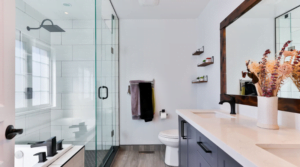
In today’s fast-paced world, finding moments of calm and connection with nature has become increasingly important. One way to achieve this is by bringing the outdoors into our living spaces through interior design. By incorporating natural elements, we can create harmonious and refreshing environments that enhance our well-being. In this article, we will explore the power of natural elements in interior design and provide practical tips on how to incorporate them into your home. Get ready to create a sanctuary that reconnects you with the beauty of nature!
The Benefits of Natural Elements in Interior Design
Creating a Calming Atmosphere: Natural elements have a soothing effect on our minds and bodies, helping to reduce stress and promote relaxation.
Enhancing Indoor Air Quality: Plants act as natural air purifiers, improving the air quality in our homes and creating a healthier living environment.
Connecting with Nature: Incorporating natural elements allows us to establish a connection with the outdoors, even when we’re inside, fostering a sense of tranquility and well-being.
Bringing Nature Inside: Practical Tips
Greenery and Plant Life:
Choosing the Right Indoor Plants: Explore different types of plants that thrive indoors and suit your lifestyle and design preferences.
Placement and Display: Strategically position plants in different areas of your home to maximize their visual impact and benefits.
Maintenance and Care: Learn how to care for indoor plants and keep them healthy and thriving.
Natural Materials and Textures:
Wood: Introduce wooden furniture, flooring, or accents to add warmth and a natural aesthetic to your space.
Stone: Incorporate natural stone elements such as countertops, backsplashes, or decorative features for an earthy and timeless appeal.
Textiles and Fibers: Choose fabrics made from natural fibers like cotton, linen, or jute to create a cozy and sustainable ambiance.
Natural Light and Views:
Embrace Natural Light: Maximize natural light by arranging furniture to allow for unobstructed views of windows and using sheer curtains or blinds to let light in.
Frame Nature’s Beauty: Position furniture and create seating areas that offer scenic views of your outdoor surroundings.
Balancing Nature and Design Harmony
Minimalism and Simplicity: Incorporate natural elements in a minimalist way, allowing their beauty to shine without overwhelming the overall design.
Color Palette: Choose earthy tones, soft greens, or muted blues to create a calming and nature-inspired color scheme.
Art and Decor: Select artwork and decor that reflect nature, such as landscape paintings, botanical prints, or sculptures inspired by natural forms.
By bringing the outdoors in and incorporating natural elements into our interior design, we can create spaces that nurture our well-being and provide a sense of connection with the natural world. From lush indoor plants to the use of natural materials, the possibilities are endless. Embrace the beauty of nature and transform your home into a sanctuary that rejuvenates and inspires.
Remember, each element you choose should be in harmony with your personal style and preferences. Whether you opt for a minimalist approach or embrace a more eclectic design, the key is to create a space that resonates with you and reflects your love for nature. So, get ready to embark on a journey of design and discover the transformative power of natural elements in your home.



